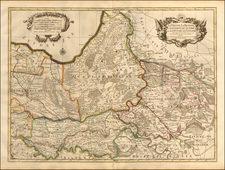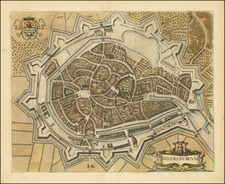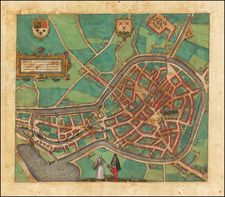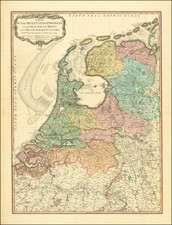Hypra Flandriarum Civitas Munitissima, produced in Cologne by Braun & Hogenberg around 1575, presents Ypres, a foremost fortified city in Flanders, renowned for its monumental town hall and significant role in the European cloth trade. Situated in the heart of Flanders, Ypres was a linchpin in the textile industry, outpacing even its contemporaneous giants such as Ghent and Bruges in the 13th century.
The late Medieval period witnessed Ypres achieving pinnacle status in Europe's cloth production hierarchy. Its meteoric rise in the 13th century can be attributed to its sizable population of 200,000 inhabitants and a staggering 4,000 weaving looms. The expansive reach of Ypres' textile trade is evident in the discovery of its cloth as far afield as central Russia, North Africa, and Syria. This geographical span serves as a testament to the city's industrial prowess and the quality of its products.
Braun's commentary further adds depth to the understanding of the city's architectural and cultural nuances. The town hall, a magnificent edifice situated at the marketplace, stands out not just for its grandeur but also for a peculiar observation: the conspicuous absence of spiders and their webs. This absence, attributed to the salt water-treatment of the building's wooden beams sourced from Norway and Sweden, underscores the intricate architectural methodologies and cultural beliefs of the time.
Furthermore, the biannual fairs held in Ypres exemplify the city's significance as a hub for trade, especially in cloth and wool. These fairs, acting as major commercial events, reiterate the dynamic trade relations the Flemings maintained, emphasizing the vibrancy of the city's economy. However, as history progressed, Ypres faced an economic downturn in the 15th century, a consequence of the rise of English wool in the global market.
In sum, Hypra Flandriarum Civitas Munitissima is not merely a representation of a city's topographical layout. It encapsulates the essence of Ypres in its prime, emphasizing its monumental architectural achievements, the quirks of its local folklore, and its unparalleled stature in the realm of textile production and trade.
Georg Braun (1541-1622) was born and died in Cologne. His primary vocation was as Catholic cleric; he spent thirty-seven years as canon and dean at the church St. Maria ad Gradus, in Cologne. Braun was the chief editor of the Civitates orbis terrarum, the greatest book of town views ever published. His job entailed hiring artists, acquiring source material for the maps and views, and writing the text. In this role, he was assisted by Abraham Ortelius. Braun lived into his 80s, and he was the only member of the original team to witness the publication of the sixth volume in 1617.
Frans Hogenberg (ca. 1540-ca. 1590) was a Flemish and German engraver and mapmaker who also painted. He was born in Mechelen, south of Antwerp, the son of wood engraver and etcher Nicolas Hogenberg. Together with his father, brother (Remigius), uncle, and cousins, Frans was one member of a prominent artistic family in the Netherlands.
During the 1550s, Frans worked in Antwerp with the famous mapmaker Abraham Ortelius. There, he engraved the maps for Ortelius’ groundbreaking first atlas, published in Antwerp in 1570, along with Johannes van Deotecum and Ambrosius and Ferdinand Arsenius. It is suspected he engraved the title page as well. Later, Ortelius supported Hogenberg with information for a different project, the Civitates orbis terrarium (edited by Georg Braun, engraved by Hogenberg, published in six volumes, Cologne, 1572-1617). Hogenberg engraved the majority of the work’s 546 prospects and views.
It is possible that Frans spent some time in England while fleeing from religious persecution, but he was living and working in Cologne by 1580. That is the city where he died around 1590. In addition to his maps, he is known for his historical allegories and portraits. His brother, Remigius, also went on to some fame as an engraver, and he died around the same time as his brother.












![[Denmark, Netherlands, Belgium, North Sea] Europ IIII Tab](https://storage.googleapis.com/raremaps/img/small/89170.jpg)
![[ American Revolution - Satirical Warning To Dutch Commerce ] Den Door List en Geweld Aangevallen Leeuw.](https://storage.googleapis.com/raremaps/img/small/99580.jpg)
